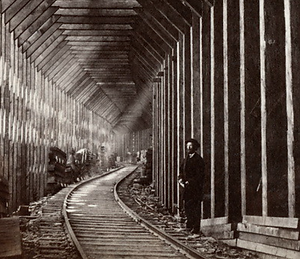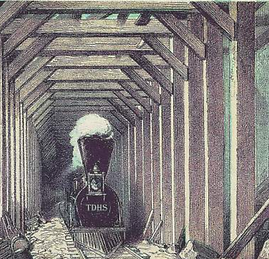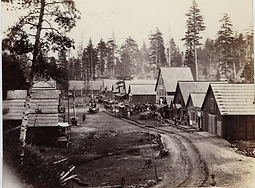
Niart - ML
2022 Donner Summit

Donner lake






Donner Summit


DSHS3020_Building along Dutch Flat Donner Lake Wagon Rd at Donner Pass-Alfred Hard

Freight wagons on DFDLWR road in Donner Pass-Alfred Hart

Camp at top of Donner Pass along DFDLWR-Alfred Hart


DSHS0045_AlfredHart185-Depot at Cisco altitude 5900 feet

Crested Peak and Tunnel No10-Eastern slpoe of Western Summit 1870

Freight wagons on snowy DFDLWR at Donner 1867

Map of railroad and summit hotel 1884
Donner Tunnel

Shaft house over Tunnel6-Alfred Hart


Interior of Tunnel 6 at Donner Pass-Alfred Hart
Chinese Workers







External Links
Accessories

Source: Alamy





Source: https://forum.reapermini.com/index.php?/topic/83427-terraincrate-lost-mine-set-plus-some-extras/
Snow Shed
Source: http://www.donnersummithistoricalsociety.org/pages/exhibits/snowsheds.html
Donner Summit gets 35-40 feet of snow a year and sometimes 60 or 70 feet. Snow drifts can be dozens of feet high. And then there are avalanches. In January, 1870, just a few months after the Golden Spike was pounded into place completing the first transcontinental railroad, an avalanche covered and tore away hundreds of feet of track. A blizzard followed. Miles of track were blocked and it kept snowing. The snow shovelers and buckers (engines with plows) could not make headway. Workers cleared for six days and still there were 7 miles of snow covered track to go. California was cut off from the nation.
Eventually snow removal improved and sheds were removed. Remaining sheds were rebuilt of concrete so that collapse was no longer a threat. The thousands of workers are gone and with them their towns.




Donner Strike
150 Years Ago, Chinese Railroad Workers Staged the Era's Largest Labor Strike
On June 25, 1867, thousands of Chinese railroad workers staged a strike to demand equal pay to white laborers, shorter workdays, and better conditions.
By Chris Fuchs
It happened somewhere between mile 92 and 119.
The Chinese railroad workers were grading and digging tunnels across a stretch of the Sierras when they decided to lay down their tools. It was the end of June 1867 and snow still covered the mountain tops.
Chinese workers wanted pay equal to whites, shorter workdays, and better conditions for building the country’s first transcontinental railroad.
So they put them to their employer, the Central Pacific Railroad, and a strike was on.
It ended after Central Pacific director Charles Crocker choked off food, supplies, and transportation to thousands of Chinese laborers who lived in camps where they worked.
Disparities between Chinese and white workers set the stage for the June 1867 work stoppage. The Chinese had seen a pay increase from $31 to $35 per month by Spring 1867, but it fell short of the $40 monthly salaries whites were pulling in, Obenzinger said.
They were also toiling longer hours, often under dangerous conditions, whipped or restrained if they left to seek employment elsewhere. And unlike whites, the Chinese had to foot the bill for their lodging, food, and tools, according to the project.
When the strike went down on June 25, 1867, some 5,000 Chinese were at work between the California towns of Cisco and Truckee, just west of the Nevada border.

Neighboring Areas



Reno is a city in the northwest section of the U.S. state of Nevada, along the Nevada-California border, about 22 miles (35 km) from Lake Tahoe source: Wiki

China Town area
Chinese Workers & Donner Summit

Donner Summit - the most important historical square mile in California and maybe the entire Western U.S. Native Americans summered on Donner Summit for thousands of years before the arrival of European Americans.
Donner Summit is the site of the first transcontinental railroad, the first transcontinental highway (the Lincoln Highway), the first transcontinental air route, and the first transcontinental telephone line.
The story of the Donner Pass Tunnels is one of the great stories of American history. It’s also one of the least known. Even less well known is the story of the Chinese railroad workers who dug those tunnels.
The followings are taken from Peter Paccone's Article : The Chinese Railroad Workers and the Donner Summit Tunnels; https://ppaccone.medium.com/the-story-of-the-railroad-chinese-and-the-donner-pass-tunnels-45dc99b6a566
The Chinese Railroad Workers and the Donner Summit Tunnels
01. Where did they came from ? Canton, China


02. How ? wooden-hulled, sidewheel steamships.

03. Paid or Enslaved ?
The steamships would typically arrive in
carrying somewhere between 200–800 Chinese. The Chinese workers would then need to find a way to travel the approximately 100 miles from San Francisco to the Donner Pass Tunnels, with this journey often done by a combination of train, foot, and horse-drawn wagon.

The Chinese were paid for their work, receiving wages of $27 and then $30 a month, minus the cost of food and board. In contrast, Irishmen were paid $35 per month, with board provided.
“The Chinese workers were paid 30% to 50% less than their white counterparts and were given the most dangerous work.” Remember the Chinese Immigrants who Built America’s First Transcontinental Railroad
04. What, where, and how did the Chinese eat?
Nearly all the food the Chinese ate came from China, except for American chickens. Like so many exiles and expatriates throughout history, the Chinese wanted to eat their own food.

05. Where and how did the Chinese workers sleep?
The two photographs appearing below essentially answer the question.


06. How did the Chinese workers mourn the loss of their own?
Some historians estimate that from the time of Bloomer Cut until the Promontory Point photograph between 50 to 150 Chinese railroad workers died as a result of snow slides, landslides, explosions, falls, and other accidents, as well as sickness. Other historians estimate 2000 or more Chinese dead.
I’m guessing at least one Chinese worker died for every mile of track laid, and hence I’m guessing nearly 700 Chinese lost their lives working on the railroad.

07. China Wall
It is a 75 foot high hand-built retaining wall that was created to prop up the track as it moved between the two tunnels. It is incredible craftsmanship, especially to think that it is still standing over a century after it was completed.





© 2022 by Au Brothers Productions